ECONet History
How did the Environment and Climate Observing Network (ECONet) we know and love today get its start? Here, we explain that 40+ year history.
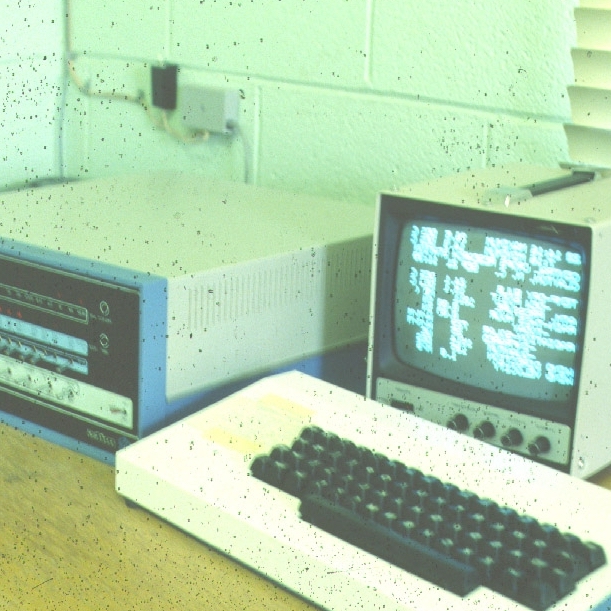
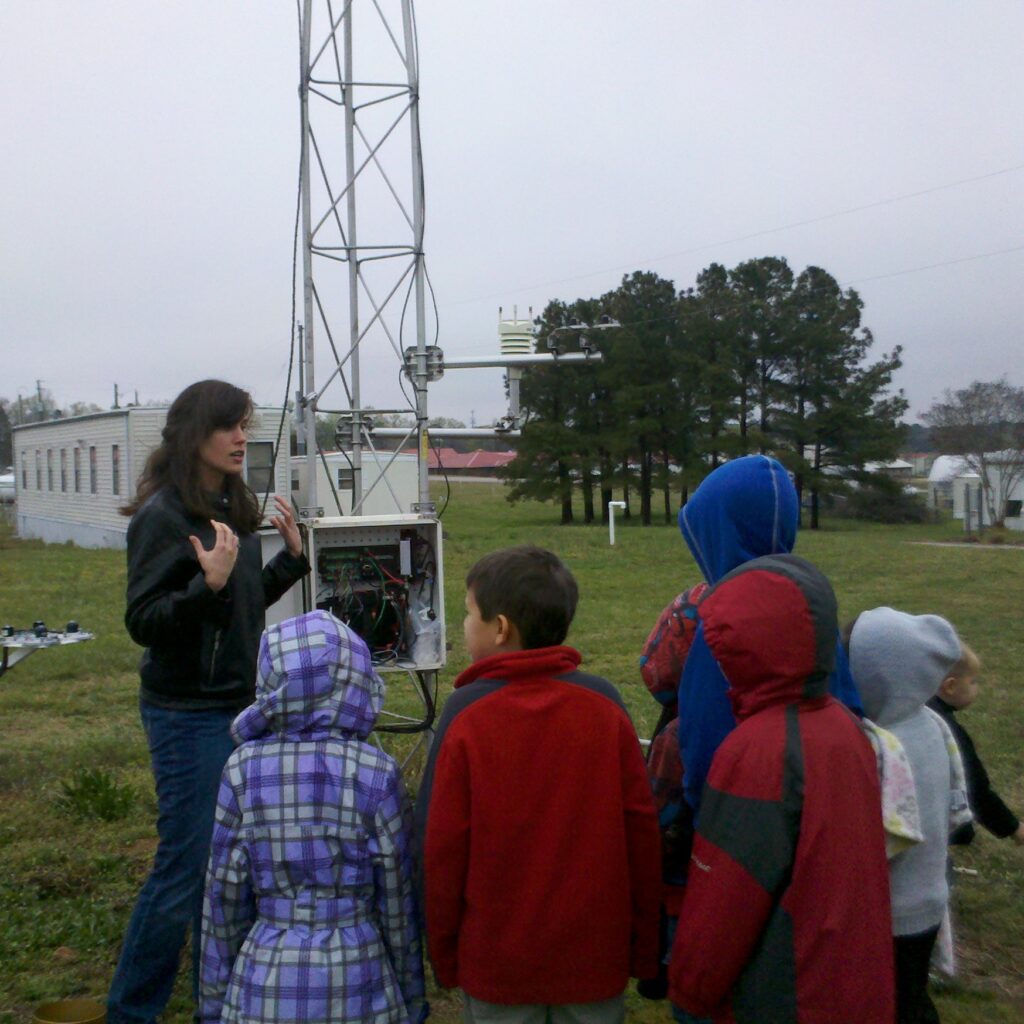

Images of ECONet over the years. (left) Early computer systems (~1980s) used to store and transmit data from the Clayton, NC (CLAY) ECONet Station back to researchers at NC State University for agricultural research. Photo Credit: Dr. James Young (middle) Rebecca Ward explaining what ECONet is and how it works to a group of students in the mid-2010s. Photo Credit: Sean Heuser (right) ECONet team servicing the Lake Wheeler (LAKE) weather station in 2021. Photo Credit: Marc Hall
Early Days
What started in 1978 as the Agriculture Network (AgNet), quickly grew over time into the Environment and Climate Observing Network (ECONet) we know and love today. Figures 1 and 2 below show how the number of AgNet stations grew quickly from 1978 to 1987. The number of AgNet stations remained at 14 throughout the 1990s (Figure 2) and AgNet was officially merged into ECONet in 2001. AgNet data were originally used exclusively by the NC Agriculture Weather Program staff in the Department of Horticultural Science at NC State University to help agricultural producers manage their operations and prepare for weather events. Besides agricultural producers, ECONet data now “…benefit[s] emergency management, agriculture, transportation, economic development, education, public health, safety, insurance, damage assessment and prevention, drought mitigation to name a few” (Raman, 1998).
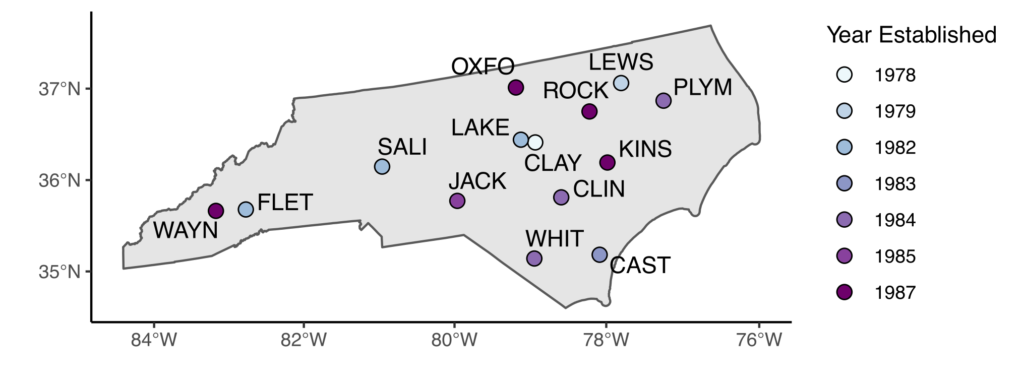
Figure 1. Map of AgNet weather stations (i.e., early ECONet weather stations) across North Carolina colored by the year they were established ranging from 1978 to 1987. Image Credit: Sheila Saia

Figure 2. Line plot of the number of cumulative stations versus the year that the station started recording data. Image Credit: Sheila Saia
Timeline from Then to Now
- 1978: The Central Crops Research Station (CLAY) weather station comes online as the first Agriculture Network (AgNet) weather station. AgNet is the precursor to ECONet. AgNet was established and instrumented with the help of Dr. James Young, a professor in the Department of Biological and Agricultural Engineering at NC State University.
- 1978-1987: A total of 14 AgNet stations are established during this time. Most are located at existing NC State University, North Carolina Agricultural Research Service, and North Carolina Department of Agriculture and Consumer Services field laboratory and research stations.
- 1991: Dr. Katharine (Katie) Perry, Professor Emeritus and Senior Vice Provost Emerita in the Department of Horticultural Science at NC State University’s College of Agricultural and Life Sciences takes over management and maintenance of AgNet through the NC Agriculture Weather Program and works in partnership with the North Carolina Agricultural Research Service and North Carolina Department of Agriculture and Consumer Services. Around this time, AgNet stations are upgraded with more advanced data loggers and sensors.
- 1997: Supervision of AgNet is transferred to the State Climate Office of North Carolina, at the time within NC State’s University’s College of Physical and Mathematical Sciences, under the leadership of Director Dr. Sethu Raman. Around this time, Dr. Raman and Dr. Perry are granted additional funding from the North Carolina Agricultural Research Service to support AgNet. This funding is used to hire more staff to support network maintenance and station tower upgrades.
- 1998: Dr. Raman publishes A Preliminary Proposal for the North Carolina Environmental & Climate Observation Network (NC ECO Net), where he emphasizes the importance of weather observations in all aspects of daily life and proposes the vision of developing “…a network of more than 100 weather and environmental observing stations across North Carolina with a minimum of one in each county.”
- 1999: The Upper Piedmont Research Station (REID) comes online as the first Emergency Management Network (EMNet) station funded through the NC Department of Public Safety, Emergency Management Division.
- 2000: Upgrades from a 3 meters tower to a 10 meters tower are completed at all AgNet stations thanks to Assistant State Climatologist and research assistant professor, Dr. Dev Dutta Niyogi. This upgrade allows AgNet stations to meet the sensing requirements of the World Meteorological Organization. At this time, NC Department of Air Quality funds 5, high elevation Department of Air Quality Network (DAQNet) stations for NC air quality monitoring. These five stations include: Pamlico Aquaculture Field Lab (AURO), Bearwallow Mountain (BEAR), Upper Mountain Research Station (LAUR), Siler City Airport (SILR), and Highway Patrol Comm Station (WILL).
- 2001: The 25th anniversary celebration at the State Climate Office of North Carolina brings us official use of “Environmental and Climate Observing Network”, which we know today as ECONet for short, as the umbrella network term for AgNet, EMNet, and DAQNet to name a few. The State Climate Office of North Carolina also moves to a common data standard and database structure (CRONOS) starting this year. Dr. Raman, announces a new vision for the State Climate Office of North Carolina: to have one ECONet station in each of North Carolina’s 100 counties.
- 2002 – 2009: ECONet consistently grows 1 to 2 stations per year during this period.
- 2006: Buckland Elementary School in Gates, NC (i.e., BUCK) becomes the first of several stations at K-12 grad schools and kicks off a new chapter of weather station science education programming for the State Climate Office of North Carolina. Other stations, which were installed between 2007-2009, are located at K-12 grade schools include BURN, NEWL, and TAYL.
- 2007: ECONet staff begin replacing data loggers and updated sensors at all stations. The newly installed data loggers collect data at 1 minute time intervals, rather than at 15 minute intervals. Staff also install an updated all-weather sensor at 2 meters to measure air temperature, station pressure, relative humidity, wind speed, wind direction, and precipitation according to American Association of State Climatologists (AASC, 1985), U.S. Environmental Protection Agency standards (EPA 1987), and World Meteorological Organization standards (WMO, 1983).
- 2008: ECONet staff install new total solar radiation and photosynthetically active radiation sensors.
- 2011: The State Climate Office of North Carolina collaborates with the NC Forest Service to install wind speed and direction sensors at 6 meters on ECONet stations. These wind sensors support fire weather current condition reports.
- 2012: ECONet staff begin replacing rain gauges at all older (i.e., pre-2007) weather stations. Additionally, staff start installing a second set of senors at 2 meters for redundancy in air temperature and relative humidity measurement. Ameen Syed, develops an in-house, multi-level (i.e., it takes soil moisture measurements at 10, 20, 30, and 40 cm depths) soil moisture sensor and starts deploying them across all ECONet sites.
- 2011-2012: The State Climate Office of North Carolina is awarded a National Mesonet Program contract to support ECONet maintenance and growth moving forward.
- 2013: ECONet staff begin installing leaf wetness sensors across all stations. The initial impitus for installing these leaf wetness index sensors came from a collaboration with Dr. Gail Wilkerson in the Department of Crop and Soil Sciences at NC State University. This research supported tomato crop and pest management.
- 2015: ECONet staff begin upgrading the communication systems on all ECONet stations from landline telephone to cellular communication. This update allows stations to report data back to computers at the State Climate Office of North Carolina every 5 minutes, rather than every 15 minutes.
- 2016: Ameen Syed retires and Sean Heuser takes on the role of ECONet Manager.
- 2018: ECONet staff begin installing black globe thermometer sensors at 2 meters to monitor heat stress.
- 2019: In collaboration with Climate Corporation and the Department of Weed Science at NC State University, the State Climate Office of North Carolina receives support to install temperature sensors at 9 meters. These data are used to monitor and forecast herbicide and pesticide spraying conditions.
- 2020: ECONet and the State Climate Office of North Carolina move to an API-based solution for retrieving data, known as CLOUDS. Cardinal and Scout data portals are launched publicly to provide user-friendly data access to ECONet data, among other North Carolina-relevant weather data networks. All of the mutli-level soil temperature sensors, which were first installed in 2012, are replaced with commercial soil moisture sensor because they were no longer functioning at several ECONet sites.
- 2022: A new ECONet Extended (ECONet Ext) site, C4EE, at the Center for Energy Education in Roanoke Rapids, NC comes online in April 2022. The first ECONet station on the Outer Banks is installed in May 2022. The Jockey’s Ridge State Park (JRSP) ECONet station is located in Nags Head, NC at the North Carolina Park by the same name. This station is made possible thanks to a collaborative effort between Jockey’s Ridge State Park, the Town of Nags Head, and the State Climate Office of North Carolina.
Early ECONet VIPs
There were several very important people (VIP) whose work had significant impact on the ECONet that we know and love today. We describe each of their unique contributions below.

Dr. James (Jim) Young
Dr. James (Jim) Young, Professor Emeritus of the Department of Biological and Agricultural Engineering (BAE) at NC State University, is one of the founding members of AgNet. In the late 1970s, Dr. Young collaborated with several other BAE staff to build hardware and software that would enable the storage and access of data collected by various commercially-made AgNet station sensors. This custom hardware and software system was needed because, at the time, there was no commercial data logging and data storage system available to meet all of AgNet’s needs. Dr. Young and his colleagues used the AgNet station data to establish and validate crop growth models. At the time, Dr. Young was conducting research on peanut crops so it’s no coincidence that the second oldest AgNet station is located at the Peanut Belt Research Station in Lewiston, NC (i.e., LEWS). Data were collected at hourly intervals, aggregated over a daily time period, and sent via phone line to a computer (see far left photo at the top of this webpage) located at the nearby NC State University agricultural research station. In those days, only 100 bits per second of data could be sent over the phone line. This is in contrast to the millions and billions of bits per second that can be sent over modern fiber optic cables (e.g., Verizon Fios, Google Fiber, etc.). Researchers could access the data from this computer and use it in their studies. To read more about Dr. Young’s research, please visit his NC State University faculty page. Image Caption: Headshot of Dr. James (Jim) Young. Photo Credit: Department of Biological and Agricultural Engineering, NC State University.
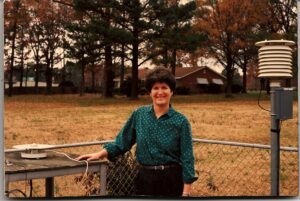
Dr. Katharine (Katie) Perry
Dr. Katharine (Katie) Perry, Professor Emeritus and Senior Vice Provost Emerita in the Department of Horticultural Science at NC State University’s College of Agricultural and Life Sciences, is an important part of the State Climate Office of North Carolina’s history. In 1991, she took over management and maintenance of 14 Agriculture Network (AgNet) weather stations in collaboration with the North Carolina Agriculture Research Service, the North Carolina Department of Agriculture & Consumer Services (NCDA&CS), and the NC Agricultural Weather Program housed in the Department of Horticultural Science in NC State University’s College of Agriculture and Life Sciences. These AgNet stations were located at field laboratory and research stations operated by NC State University, North Carolina Agriculture Research Service, and NCDA&CS. Weather data collected by AgNet stations were used by NC Agricultural Weather Program staff (including Dr. Perry) to serve agricultural producers across the state. These 14 stations continue to be an important part of our larger ECONet, which is used by agriculture, emergency management, education, natural resources management, and many other communities across the state. After supervision of AgNet weather stations was transferred to the State Climate Office of North Carolina in 1998, Dr. Perry went on to serve as Associate Dean of Administration for the NC State University College of Agriculture and Life Sciences and then became Senior Vice Provost for NC State University until her retirement in 2009. In addition to her leadership roles, Dr. Perry conducted important research on frost protection and freeze-frost forecasting in berries, fruit trees, and many other horticultural crops. To read more about her research, visit her NC State University faculty webpage. Image: station was located at the Central Crops Research Station in Clayton, NC and has since been upgraded and relocated nearby to improve measurement accuracy (i.e., current day CLAY ECONet station). Photo Credit: Dr. Katie Perry
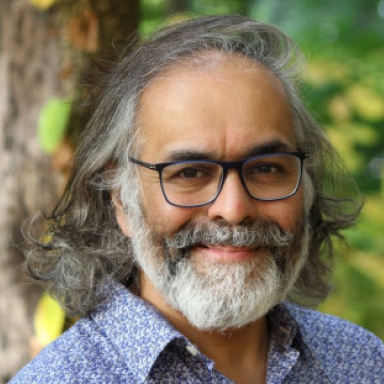
Dr. Dev Dutta Niyogi
Dr. Dev Dutta Niyogi served as the Assistant State Climatologist as well as a research assistant professor and meteorologist in the Department of Horticultural Science at NC State University from 1999 to 2005. Dr. Niyogi led efforts to update ECONet stations from 3 meter tripods to 10 meter towers, consistent with World Meterological Organization standards. ECONet continues to use this 10 meter tower standard to this day. Starting in 1997, Dr. Niyogi also added soil moisture sensors to all ECONet sites. Additionally, he supported and led the installation of 5 new Department of Air Quality Network (DAQNet) stations in 2000. You can read more about his ECONet work in this NC State University news feature. Currently, he is the John E. “Brick” Elliot Centennial Endowed Professor in the Department of Geological Sciences at the University of Texas at Austin. To read more about his research, visit his University of Texas at Austin faculty webpage. Image Caption: Headshot of Dr. Dev Dutta Niyogi. Photo Credit: Department of Geosciences, University of Texas at Austin

Ameenulla (Ameen) Syed
Mr. Ameenulla (Ameen) Syed was the State Climate Office of North Carolina Associate Director and ECONet Manager from 1999 to 2016. Under his leadership, each ECONet station was outfitted with a soil moisture probe that collected measurements at three soil depths starting in 2012. Notably, this probe was custom designed and implemented by Mr. Syed. Image Caption: Headshot of Dr. Ameed Syed. Photo Credit: State Climate Office of North Carolina, NC State University
Acknowledgements
Special thanks to Sean Heuser, Dr. Ryan Boyles, Dr. Katie Perry, and Dr. James Young for sharing their knowledge of ECONet history. Special thanks to Sean Heuser, Myleigh Neill, William LaForce, and Rebecca Ward for their feedback on this webpage.
Upon drafting this web page we learned that Dr. James Young passed away in February 2022. This was less than six months after he had shared some of this important context for AgNet (and ECONet) with Sheila Saia over Zoom. On behalf of the ECONet and State Climate Office of North Carolina staff, our thoughts and support go out to his family and friends.
References Cited
American Association of State Climatologists (AASC). 1985. Heights and Exposure Standards for Sensors on Automated Weather Stations, The State Climatologist. issue 9, volume 4.
Raman, S. 1998. A Preliminary Proposal for the North Carolina Environmental & Climate Observation Network (NC ECO Net). State Climate Office of North Carolina. Raleigh, NC.
United States Environmental Protection Agency (USEPA). 1987. On-Site Meteorological Program Guidance for Regulatory Modeling Applications, EPA-450/4-87-013. Office of Air Quality Planning and Standards, Research Triangle Parks, North Carolina 27711.
World Meteorological Organization (WMO). 1983. Guide to Meteorological Instruments and Methods of Observation. World Meteorological Organization. issue 8, 5th edition, Geneva Switzerland.